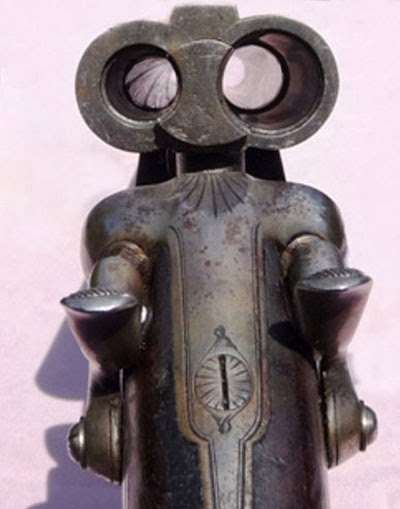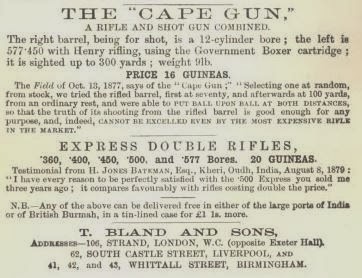Buck Conner1
Well-Known Member
- Joined
- Oct 20, 2015
- Messages
- 4,592
- Reaction score
- 558
AN ENGLISH COMBO SHOTGUN (16 GA SMOOTHBORE) - RIFLE (38 CAL. RIFLED), ca. 1870-1890.
 The gun has 33 inch barrels, overall length is 48 inches, engraved back action lock-plates unmarked, top of solid rib unmarked, no proof or makers marks. The bores have been cleaned by a gunsmith and look very good, the dimensions are ideal for 16 gauge wads and .375 round ball with a .015 patch. The tail of the lock plate, and hammers are engraved with a floral pattern. These percussion hammers are of the 1870-1890's style with a European influence on the architecture. Stocked in walnut the butt does have a few mild stripes of figure, but is essentially straight grain which is ideal for such a combination bore shotgun/rifle. The wrist and forearm are both checkered to provide a secure grip. The barrels are fitted to the stock with a single captured key. By putting the locks at half cock, and drift the wedge key loose, then the barrels can then be removed for easy cleaning. Instead of a capture slot, a groove and pin prevent the wedge key from being completely removed from the stock, which prevents loss of the fitted key.
The gun has 33 inch barrels, overall length is 48 inches, engraved back action lock-plates unmarked, top of solid rib unmarked, no proof or makers marks. The bores have been cleaned by a gunsmith and look very good, the dimensions are ideal for 16 gauge wads and .375 round ball with a .015 patch. The tail of the lock plate, and hammers are engraved with a floral pattern. These percussion hammers are of the 1870-1890's style with a European influence on the architecture. Stocked in walnut the butt does have a few mild stripes of figure, but is essentially straight grain which is ideal for such a combination bore shotgun/rifle. The wrist and forearm are both checkered to provide a secure grip. The barrels are fitted to the stock with a single captured key. By putting the locks at half cock, and drift the wedge key loose, then the barrels can then be removed for easy cleaning. Instead of a capture slot, a groove and pin prevent the wedge key from being completely removed from the stock, which prevents loss of the fitted key.
This shotgun has a 14” and 13" trigger reach, which should fit today's average size shooter well. It weighs 10.8 pounds. Stocked straight, it could easily be used by a right or left hand shooter. The brass trigger guard has a engraved bow and grip rail. The trigger guard is threaded to the front trigger plate, and a single screw mounts the grip rail to the stock. The ramrod is fitted with a large brass loading tip and looks to be original to the gun. The front sight uses the broad band and a flat wide barrel rib seen on English SXS and combination guns.
The sighting arrangement is of the European style with the rear sight having a double notch. Which side do use, right notch for the right barrel or the left notch for the right barrel - crossing over, interesting?
With some research it is believed an importer in Philadelphia by the name of J. E. Evans, 226 South. St. was bringing these guns into this location as a wholesaler in the late 1800s.
This gun was cleaned and the bores honed by a professional gunsmith in the 1970s and again recently and it has sat in a gun safe since then.





This shotgun has a 14” and 13" trigger reach, which should fit today's average size shooter well. It weighs 10.8 pounds. Stocked straight, it could easily be used by a right or left hand shooter. The brass trigger guard has a engraved bow and grip rail. The trigger guard is threaded to the front trigger plate, and a single screw mounts the grip rail to the stock. The ramrod is fitted with a large brass loading tip and looks to be original to the gun. The front sight uses the broad band and a flat wide barrel rib seen on English SXS and combination guns.
The sighting arrangement is of the European style with the rear sight having a double notch. Which side do use, right notch for the right barrel or the left notch for the right barrel - crossing over, interesting?
With some research it is believed an importer in Philadelphia by the name of J. E. Evans, 226 South. St. was bringing these guns into this location as a wholesaler in the late 1800s.
This gun was cleaned and the bores honed by a professional gunsmith in the 1970s and again recently and it has sat in a gun safe since then.












